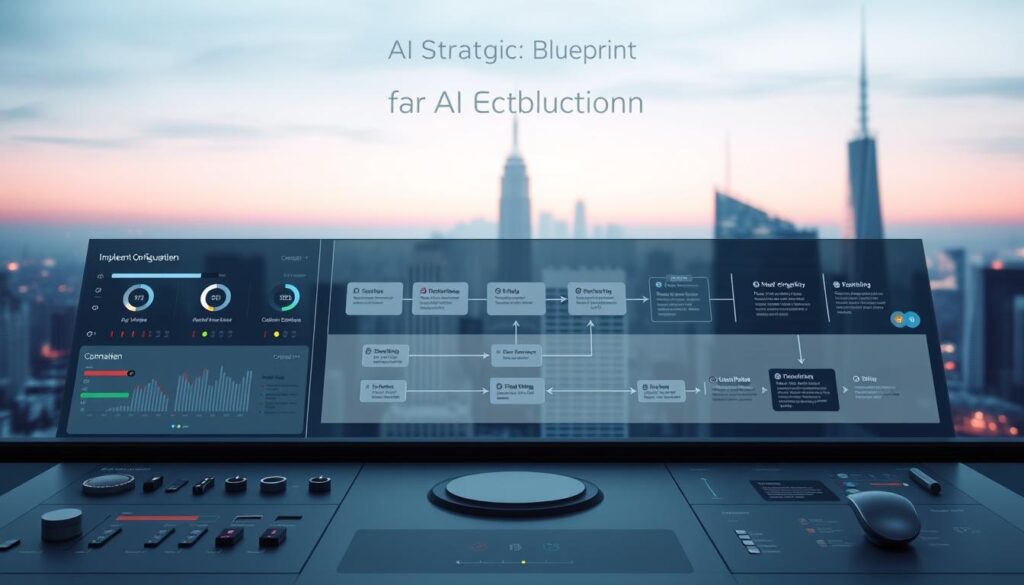“Innovation distinguishes between a leader and a follower,” said Steve Jobs. In today’s fast-paced marketing world, innovation is key to staying ahead. AI-driven tools are transforming how businesses connect with their audiences, offering new ways to enhance interaction and satisfaction.
These tools automate repetitive tasks, freeing up teams to focus on creative strategies. They also provide real-time insights, enabling continuous optimization of campaigns1. By leveraging AI, marketers can craft personalized experiences that resonate deeply with their audience.
For example, AI can analyze customer feedback to identify key sentiments, helping businesses refine their approach1. This data-driven method ensures that every decision is backed by actionable insights. The result? A more meaningful and impactful marketing experience.
Key Takeaways
- AI tools automate tasks, allowing teams to focus on creativity.
- Real-time insights help optimize marketing campaigns.
- Personalized experiences enhance audience satisfaction.
- AI analyzes feedback to improve strategies.
- Data-driven decisions lead to better results.
Introduction to AI-Powered Customer Engagement

Artificial intelligence has reshaped the way businesses connect with their audience. What started as a buzzword has now become a cornerstone of modern marketing strategies. AI’s ability to analyze data and predict trends has made it indispensable for brands aiming to stay competitive.
The Evolution of AI in Marketing
AI’s journey in marketing began with simple automation tasks. Over time, it evolved into a robust tool capable of deep data analysis and personalization. Today, AI helps brands understand customer behavior, optimize campaigns, and deliver tailored experiences. For instance, AI-driven tools can analyze click patterns to predict what customers want next2.
This evolution has been fueled by advancements in machine learning and natural language processing. These technologies enable AI to process vast amounts of data, uncovering insights that were previously hidden. As a result, businesses can now make data-driven decisions with confidence.
Benefits of AI-Driven Engagement
One of the most significant advantages of AI is its ability to automate repetitive tasks. This frees up time for teams to focus on creative strategies. Additionally, AI provides real-time analytics, allowing brands to adapt quickly to changing trends3.
AI also enhances customer interaction by offering personalized experiences. For example, it can analyze user behavior to recommend products or services tailored to individual preferences. This level of personalization not only boosts satisfaction but also strengthens brand loyalty.
Moreover, AI tools can analyze customer feedback to identify key sentiments. This helps businesses refine their approach and address pain points effectively. By leveraging these insights, brands can create more meaningful and impactful interactions.
The Role of AI in Enhancing Customer Engagement

The shift from traditional methods to AI-driven strategies is revolutionizing how businesses interact with their audience. While conventional approaches rely heavily on manual effort and intuition, AI introduces a data-driven, proactive approach that delivers measurable results.
AI vs Traditional Strategies
Traditional marketing often involves guesswork and broad campaigns that may not resonate with every customer. In contrast, AI leverages machine analysis to process vast amounts of data, uncovering insights that drive personalized strategies4. For example, AI can analyze browsing patterns and purchase history to suggest products tailored to individual preferences, leading to a 20% increase in conversion rates5.
One of the most significant advantages of AI is its ability to operate 24/7, handling multiple inquiries simultaneously. This ensures that customer interaction is seamless and efficient, unlike traditional contact centers that are limited by human availability4. Additionally, AI-powered chatbots can handle up to 80% of routine inquiries, freeing up human agents for more complex issues5.
Real-time data processing is another area where AI outperforms traditional methods. By analyzing customer feedback and sentiment across various channels, AI tools can provide actionable insights that refine marketing strategies6. This level of precision ensures that businesses can adapt quickly to changing trends, enhancing overall engagement.
In today’s digital landscape, having a modern strategy is crucial. Businesses that integrate AI into their marketing efforts gain a competitive edge by improving customer satisfaction and reducing ticket times4. The result is a more proactive approach to customer relationships, fostering loyalty and long-term success.
How to Assess Your Current Engagement Strategy

Understanding your current approach is the first step toward meaningful improvement. A well-defined strategy ensures you’re meeting your audience’s needs effectively. But how do you know if your efforts are truly impactful? The answer lies in a systematic review of your processes.
Identifying Gaps in Customer Interaction
Start by examining your interaction points. Are there areas where communication feels disjointed or ineffective? For example, brands that prioritize seamless experiences see retention rates increase by up to 60%7. Look for patterns in feedback to pinpoint where improvements are needed.
Analyzing metrics like customer satisfaction (CSAT) and net promoter scores (NPS) can reveal friction points7. These insights help you understand what’s working and what’s not. Regularly measuring these indicators ensures your approach stays aligned with audience expectations.
Leveraging Data Analytics for Insights
Data is the backbone of any successful plan. Use analytics to gather actionable information about your performance. For instance, AI tools can analyze massive amounts of datum, including customer lifetime value and churn prediction8. This helps you tailor your strategies to individual needs.
Predictive capabilities also allow businesses to anticipate customer interests, improving the overall experience9. By interpreting messages from feedback, you can refine your approach and drive long-term success. A data-driven method ensures every decision is backed by evidence.
Step-by-Step Guide to Implementing AI Prompts

Implementing AI-driven strategies requires a clear roadmap to ensure success. By following a structured approach, businesses can maximize the potential of AI prompts to enhance their marketing efforts. This guide breaks down the process into actionable steps, from setting goals to measuring results.
Setting Goals and Objectives
Start by defining what you want to achieve with AI prompts. Are you aiming to improve response accuracy or enhance user satisfaction? Clear objectives ensure your efforts are aligned with your company’s broader goals. For example, tailored prompts can boost user experience by providing more relevant responses10.
Break down your goals into measurable targets. This could include reducing follow-ups by 20% or increasing response accuracy by 30%. A well-defined plan ensures every step contributes to your overall strategy.
Defining Key Performance Indicators
KPIs are essential for tracking the effectiveness of your AI prompts. Metrics like response time, user satisfaction, and conversion rates provide valuable insights. Companies that use AI for customer service see a 30% reduction in response times11.
Regularly analyze these metrics to identify areas for improvement. For instance, if your prompts are not generating the desired results, adjust them based on user feedback. This iterative process ensures continuous refinement and better outcomes.
Leverage analytics to guide your strategy. By interpreting data, you can make informed decisions that align with your company’s objectives. This data-driven approach ensures every prompt is optimized for maximum impact.
Personalizing Customer Experiences with AI

In today’s digital age, personalization is no longer a luxury but a necessity for businesses. With 71% of consumers expecting tailored interactions, companies must leverage AI to meet these demands12. AI-driven tools analyze behavior and preferences, enabling brands to deliver hyper-personalized experiences that resonate deeply.
Using AI for Customer Segmentation
AI transforms how businesses segment their audience. By analyzing data like purchase history and browsing patterns, machine learning identifies distinct customer groups. This allows brands to create targeted campaigns that address specific needs and preferences12.
For example, segmented email campaigns can boost revenue by up to 760%12. AI ensures that every message feels relevant, increasing the likelihood of conversion. This level of precision is unmatched by traditional methods.
Tailoring Content Using Machine Learning
Machine learning plays a pivotal role in crafting personalized content. It analyzes customer interactions to recommend products or services that align with individual preferences. This not only enhances the experience but also builds loyalty13.
Brands like Yum Brands have successfully used AI to reduce churn and increase engagement13. By delivering customized offers, they’ve created meaningful connections with their audience. This approach ensures that every interaction feels unique and valuable.
Practical tips for leveraging segmentation data include regularly updating customer profiles and testing different messaging strategies. Experimentation is key to continuous improvement and staying ahead in a competitive market.
Improving Customer Engagement with AI Prompts

Integrating AI prompts into communication channels can transform how businesses connect with their audience. These tools streamline interaction, ensuring every message feels tailored and relevant. By embedding prompts into platforms like chatbots and email systems, companies can enhance customer engagement while saving time and resources14.
Embedding Prompts in Communication Platforms
Start by identifying key touchpoints where prompts can add value. For instance, chatbots powered by AI can handle up to 80% of routine inquiries, providing instant support14. This not only reduces response times but also ensures consistency in communication. Email campaigns can also benefit from AI-driven prompts, which analyze user behavior to deliver personalized content15.
Clear and concise prompts are essential for driving meaningful conversations. Use natural language processing (NLP) to craft messages that resonate with your audience. For example, prompts that ask open-ended questions can encourage deeper interaction, leading to higher satisfaction rates16.
Examples of Effective AI Prompts
Real-world examples highlight the power of well-crafted prompts. E-commerce platforms use AI to recommend products based on browsing history, increasing conversion rates by 20%15. Similarly, customer service chatbots can provide real-time order updates, reducing inquiries by 30%16.
Another example is personalized email campaigns. By leveraging AI prompts, brands can segment their audience and deliver tailored offers, boosting revenue by up to 760%14. These examples demonstrate how prompts can drive both sales and satisfaction.
Best Practices for Prompt Integration
Maintaining a personalized tone is crucial, even when automating responses. Use data analytics to refine prompts based on customer feedback, ensuring they remain relevant and effective15. Regularly test and adjust prompts to align with changing audience needs.
Finally, measure the impact of your prompts using key performance indicators (KPIs). Metrics like response time, satisfaction scores, and conversion rates provide valuable insights for continuous improvement16. By following these best practices, businesses can maximize the benefits of AI-driven customer engagement.
Leveraging Data-Driven Insights for Business Growth

Data has become the backbone of modern business strategies, driving decisions that fuel growth and innovation. By harnessing advanced analytics, companies can uncover patterns in behavior and preferences, transforming raw datum into actionable insights.
AI-powered tools analyze customer interactions in real-time, identifying trends and predicting future needs17. For example, predictive analytics can forecast purchasing patterns, enabling businesses to tailor their product offerings and marketing plans18.
Analyzing Consumer Behavior with AI
Understanding customer behavior is key to staying competitive. AI processes vast amounts of datum, revealing insights into click patterns, browsing habits, and purchasing decisions17. This information helps businesses create personalized experiences that resonate with their audience.
For instance, companies using AI-driven analytics see a 20% increase in engagement rates compared to traditional methods18. By segmenting audiences based on behavior, brands can deliver targeted campaigns that drive conversions and loyalty.
Real-time analytics also allow businesses to adapt quickly to changing trends. Monitoring click patterns and feedback ensures that every decision is backed by data, maximizing the opportunity for growth19.
“80% of consumers are more likely to make a purchase when brands offer personalized experiences.”19
By integrating these insights into a cohesive plan, businesses can refine their strategies and achieve long-term success. The result is a data-driven approach that not only enhances customer satisfaction but also drives measurable results.
Developing Effective Marketing and Content Strategies

The fusion of storytelling and SEO can elevate your brand’s digital presence. In today’s competitive landscape, creating authentic narratives that resonate with your audience is crucial. At the same time, leveraging tools like AI ensures your content is optimized for search engines, driving organic traffic and enhancing visibility.
Crafting Compelling Brand Storytelling
Authentic storytelling builds trust and fosters emotional connections. By understanding your audience’s needs and values, you can craft narratives that align with their experience. For example, brands that use AI to analyze click patterns and feedback can tailor their messaging to address specific pain points20.
AI-powered prompts can also generate creative ideas, helping teams develop unique angles for their stories. This not only saves time but also ensures consistency across all marketing channels21.
Optimizing SEO with AI Tools
AI tools are revolutionizing how businesses approach SEO. By analyzing search trends and user behavior, these tools can identify high-traffic keywords and suggest long-tail phrases20. This data-driven approach ensures your content ranks higher and reaches the right audience.
For instance, AI-driven platforms can recommend content improvements based on real-time click data, enhancing both relevance and performance22. Integrating machine learning into your SEO strategy allows for continuous optimization, keeping your brand ahead of the curve.
“67% of marketers plan to use both generative and predictive AI within the next 18 months to enhance their strategies.”21
By combining creative storytelling with technical precision, businesses can create impactful marketing strategies that drive results. Whether it’s refining your brand narrative or optimizing your content for search engines, AI offers the tools and insights needed to succeed in today’s digital landscape.
Building Case Studies to Showcase Success with AI

Case studies are powerful tools for demonstrating the measurable success of AI-driven strategies. They provide a clear narrative of how technology transforms business outcomes. By documenting real-world examples, companies can highlight the tangible benefits of their investments.
Documenting Customer Journeys
Start by mapping the customer journey from initial contact to final conversion. This process reveals key touchpoints where AI enhances the experience. For example, JetBlue’s Customer 360 Initiative integrated data sources to improve interactions, achieving significant ROI within two years23.
Use metrics like click patterns and satisfaction scores to identify areas for improvement. Carrefour’s AI chatbot, Hopla, personalized recommendations, boosting user-friendly interactions23. These insights help refine strategies and ensure alignment with customer needs.
Measuring Impact and ROI
Quantifying the impact of AI is essential for validating its effectiveness. Telenor’s conversational AI virtual agent, Telmi, achieved ROI goals within the first year by providing instant assistance23. Metrics like reduced response times and increased satisfaction scores demonstrate measurable success.
AI-driven predictive analytics, like those used by CAA Club Group, reduced service forecast time by 30%23. These results not only validate the technology but also provide benchmarks for future planning.
“Companies that excel in customer experience grow revenues 4%-8% above their market.”24
By leveraging data-driven insights, businesses can create compelling case studies that highlight the transformative power of AI. These narratives serve as valuable tools for strategic decision-making and continuous improvement.
Employing Chatbots and Automation Tools

Chatbots and automation tools are transforming how businesses interact with their audience, offering seamless support and personalized experiences. These tools act as virtual assistants, handling inquiries and providing instant responses, which enhances overall service quality25.
Benefits of 24/7 Engagement
One of the most significant advantages of chatbots is their ability to provide round-the-clock support. This ensures that customers can receive assistance at any time, increasing satisfaction and fostering loyalty25. For example, retailers like H&M and Sephora have seen quicker response times, leading to improved engagement rates25.
Automated systems also gather valuable data on customer interactions, which can be analyzed to refine strategies and improve processes25. This continuous feedback loop ensures that businesses stay aligned with their audience’s needs.
Streamlining Customer Service Processes
Chatbots streamline service by handling routine inquiries, freeing up human agents for more complex tasks. This not only reduces response times but also cuts operational costs26. For instance, Photobucket improved its first resolution time by 17% after implementing a chatbot26.
Integrating chatbots across multiple platforms ensures consistency in communication. Practical tips include refining chatbot scripts based on real-time interactions and using A/B testing to identify the most effective messaging27.
“72% of business leaders prioritize expanding AI and chatbots across customer experience within the next 12 months.”26
By leveraging these tools, businesses can achieve better click-through rates and higher interest levels. The use of AI chatbots in customer service is a game-changer, offering both efficiency and personalization.
Integrating Machine Learning and NLP for Better Interaction

The combination of machine learning and natural language processing is revolutionizing how businesses interact with their audience. These technologies work together to create more natural and effective communication, ensuring every interaction feels personalized and meaningful.
Enhancing Natural Language Understanding
At the core of this transformation is natural language processing, which enables systems to understand and respond to user queries accurately. By analyzing patterns in language, NLP-powered tools can detect intent and context, leading to more relevant responses28.
For example, chatbots using NLP can handle a large volume of inquiries, freeing human agents to focus on complex tasks28. This not only improves efficiency but also enhances the overall experience for users.
Sentiment analysis, a key NLP technique, allows systems to detect emotional tones in user messages. This enables more personalized and empathetic responses, which are crucial for building trust28.
Practical Steps for Integration
Integrating these technologies into existing platforms requires a strategic approach. Start by identifying key areas where machine learning and NLP can add value, such as customer support or feedback analysis29.
Use analytics to gather data on user preferences and behavior. This information helps fine-tune the interaction process, ensuring it aligns with audience needs28.
Platforms like Google Dialogflow and Microsoft Azure Bot Service offer robust tools for implementing NLP-driven solutions. These platforms support continuous learning, allowing systems to improve over time28.
“Companies using NLP-powered chatbots report significant reductions in response times, enhancing customer satisfaction.”28
By leveraging these technologies, businesses can create smoother and more personalized interactions. This not only drives satisfaction but also fosters long-term loyalty.
Overcoming Implementation Challenges with AI
Adopting AI in business operations comes with its own set of challenges, but the rewards are worth the effort. From ensuring data quality to managing costs, companies must navigate these hurdles to unlock AI’s full potential. A structured approach can help businesses overcome these obstacles and achieve successful integration.
Ensuring Data Quality and Ethical Use
High-quality datum is the foundation of effective AI systems. Without accurate and reliable data, AI tools cannot deliver meaningful insights. In fact, 70% of organizations cite data quality as a significant barrier to successful AI implementation30.
To address this, companies should invest in robust data management practices. Regularly cleaning and updating datasets ensures that AI models remain accurate and relevant. Additionally, ethical considerations must guide AI usage to maintain customer trust and comply with regulations31.
Managing Costs and Resources Effectively
Implementing AI requires significant investment in both time and resources. Poor planning can lead to suboptimal performance and increased costs32. To manage this, businesses should start with a clear process and phased approach.
For example, focusing on high-impact areas first can yield quick wins and justify further investment. Companies should also explore partnerships and collaborative projects to accelerate AI adoption while managing budgets effectively30.
By balancing costs with strategic priorities, businesses can ensure that their AI initiatives align with long-term goals. This approach not only maximizes ROI but also fosters innovation and growth.
“90% of businesses acknowledge the importance of ethical AI practices in maintaining user trust.”30
For more insights on how AI is transforming industries, explore AI innovations in finance.
Future Trends in AI and Customer Engagement
The future of AI in business is brimming with possibilities, reshaping how companies connect with their audiences. As technology evolves, new trends are emerging that will redefine the marketing landscape. Businesses that stay ahead of these advancements will unlock significant opportunities for growth and innovation.
Emerging Technologies to Watch
One of the most exciting trends is the rise of AI-powered predictive analytics. By analyzing vast amounts of datum, these tools can forecast customer behavior with remarkable accuracy. For example, Spotify’s “Discover Weekly” playlists have engaged 40 million unique users, resulting in 5 billion tracks streamed33.
Another game-changer is AI-driven personalization. Companies like Amazon use AI to generate billions of size recommendations monthly, enhancing the customer experience33. These technologies not only improve satisfaction but also strengthen brand loyalty.
Preparing for Future AI Advancements
To capitalize on these opportunities, businesses must invest in the right platforms and tools. For instance, Expedia’s AI-driven travel planning feature utilizes 1.26 quadrillion variables to provide personalized trip options33. This level of precision ensures that every click counts.
Continuous learning is also crucial. By leveraging analytics, companies can refine their strategies and adapt to changing trends. Early warning systems, for example, monitor engagement metrics to flag declining usage patterns, allowing for proactive interventions34.
“73% of consumers believe AI has the potential to positively influence their customer experience.”33
By embracing these advancements, businesses can create meaningful connections with their audience. The future of AI is not just about technology—it’s about transforming the way we interact and grow.
Conclusion
Embracing innovative technologies is essential for businesses aiming to stay competitive in today’s market. By leveraging AI-driven tools, companies can enhance customer satisfaction and build long-term loyalty. These tools provide personalized experiences, ensuring every message resonates with the audience35.
Implementing these strategies leads to measurable results. For instance, click-through rates improve significantly when content is tailored to individual preferences36. This not only boosts interest but also strengthens the brand’s reputation.
To stay ahead, businesses must adopt a data-driven plan. Analyzing trends and acting on insights ensures continuous growth. Start integrating these tools today to transform your approach and achieve lasting success.
FAQ
What is AI-powered engagement, and how does it work?
How can AI improve marketing strategies?
What are the benefits of using chatbots for engagement?
How does AI help in personalizing customer experiences?
What challenges might businesses face when implementing AI?
How can businesses measure the success of AI-driven engagement?
What role does machine learning play in customer interaction?
What are the future trends in AI for engagement?
Source Links
- Top 5 Best AI Prompts for Proactive Customer Engagement
- The next frontier of customer engagement: AI-enabled customer service
- Introducing Customer Engagement Suite with Google AI
- The Impact of AI on Customer Engagement
- Using AI to Improve Customer Engagement | ON24
- Role of artificial intelligence in customer engagement: a systematic review and future research directions
- Build a Winning Customer Engagement Strategy in Just 5 Steps
- 4 Ways AI Can Be Used for Better Customer Engagement
- The Role of AI in Improving Customer Engagement Strategies
- AI Prompts: Essential Guide with Types & Best Practices [2025]
- An In-Depth Guide on AI Prompt Engineering for Beginners
- How AI Powered Personalization is Transforming CX
- AI in Customer Experience (CX): The Ultimate Guide in 2025 | SmartDev
- 25+ AI prompts for Marketing in 2025
- 7 AI Prompts For Small Business Service
- Leveraging AI to Improve Customer Engagement | BairesDev
- Your Complete Guide To AI and Customer Data
- Leveraging Data-Driven Decisions to Boost Customer Success – 5 Tips
- What is Data-Driven Marketing? Leverage Data to Drive Results
- 40 AI prompts to boost your marketing team’s creativity and efficiency – Work Life by Atlassian
- 6 AI Prompts for Small Business Marketing
- AI Content Marketing Prompts: What They Are & How to Write Them | Copy.ai
- Case Studies: Success Stories of AI in Customer Experience
- Generative AI for Customer Experience: 17 Cases from Global Brands
- AI Chatbots Enhancing Customer Engagement: A New Era of Connection – Stellar
- Top 22 benefits of chatbots for businesses and customers
- Benefits of Chatbots | IBM
- Improving Customer Engagement through Natural Language Processing in AI Chat Bot Development
- AI in Customer Service: Revolutionizing Digital Retail
- Overcoming AI Implementation Challenges: Success Strategies
- Explore How AI-driven Solutions Enhance Customer Engagement
- Improving CX by Overcoming the Challenges of AI Support – Help Scout
- How AI Technology Will Transform Customer Engagement
- How AI Can Enhance Customer Engagement in SaaS
- Enhancing Customer Engagement with AI in Small Businesses
- AI Customer Experience: Enhancing Engagement – Aim Technologies







